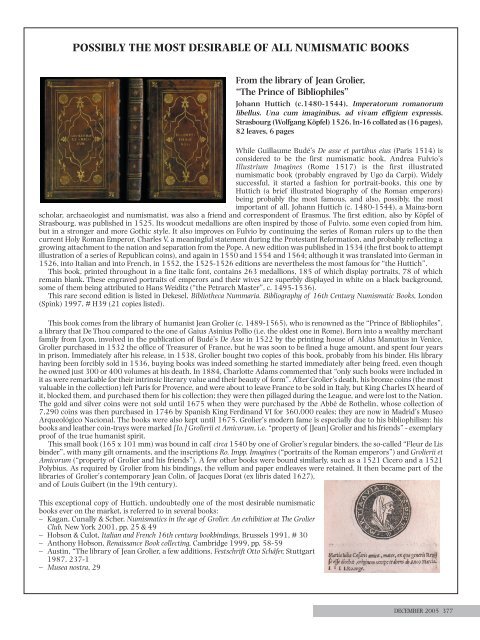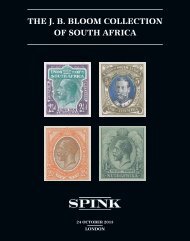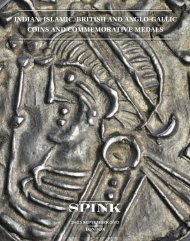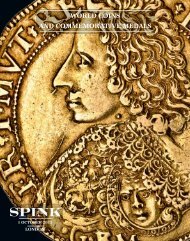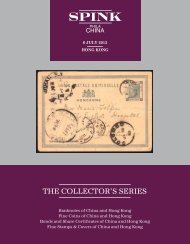Dec 05 Editorial 29/11/05 4:27 pm Page 376TABLE 1FIGURE 1Over the last thirty years, a number of scholars have debated thedating of the Bulgarian Imitations, and particularly the question ofwhether they were introduced before or after 1204 7 . FollowingTouratsoglou’s original suggestion 8 , the most recent arguments infavour of a post-1204 date were presented by Bendall 9 , andHristovska 10 at the symposium “Coinage in the Balkans, ninth tofourteenth centuries – Forty Years on” held in honour of Prof. D.M.Metcalf in Oxford (1-3 September 2005).GRAPH 1The geographical provenance and composition of the London1966 hoard supports the arguments of Bendall and Hristovska.While 107 specimens remain unidentified, for they were uncleanedand worn, the main body of the London 1966 hoard provides a usefulsample that fixes the date of the Bulgarian Imitations by reference tothe Latin Imitations and the issues of Theodore I. Graph 1 confirmsthe different relative proportions of the Bulgarian Types A, B and C 11 ,which are on weight-standards ranging between c. 2.3g and c. 2.6g.Moreover, it shows that Type C persisted in circulation longer thanthe other Bulgarian imitative types.The age-profile of the London 1966 hoard is thus highlyinteresting. Nevertheless, more finds are still required in order tobring corroboration of the interpretation and dating of the BulgarianImitatives proposed by Touratsoglou and his followers.Footnotes:1. Mr. Simon Bendall recalls seeing and cleaning the majority of the coins in1966.The writer would like to thank Mr. Massimiliano Tursi, who kindly madethe group of coins available for study enabling a record of the contents tobe made.2. Gurkovo hoard, Stara Zagora region. See I. Ǐordanov, Moneti i monetnoobrǔshtenie v srednovekovna Bǔlgariia 1081-1261 (Sofia, 1984), p. 158,no. 56.3. Ustra hoard, 1972, excavations in Ustra fortress. See I. Ǐordanov, Monetii monetno obrǔshtenie v srednovekovna Bǔlgariia 1081-1261 (Sofia, 1984),p. 221, no. 189; CH, 4 (1978), p. 63, no. 197; Ǐ. Iurukova, ‘Monetnitenakhodki, otkriti v Bǔlgariia prez 1971 i 1972 g.’, Archaeologia, 19.1(1977), p. 72.4. Veroia hoard, 1963. See T. Hackens, ‘Un trésor byzantin à São Paulo(monnaies scyphates en bronze provenant de Béroia, Macédoine)’,Dedalo, 1.2 (1965), pp. 13-25; M. Galani-Krikou – Y. Nikolaou –M. Caramessini-Oikonomidou – V. Penna – I. Touratsoglou – I. Tsourti,Corpus of Byzantine Coin Hoards in the Numismatic Museum (Athens,2002), p. 123, no. 116; D.M. Metcalf, Coinage of the Crusades and the LatinEast in the Ashmolean Museum, Oxford (London, 1995), p. 335, no. 128; I.Touratsoglou, ‘Unpublished Byzantine Hoards of Billon Tracheafrom Greek Macedonia and Thrace’, BSt, 14 (1973), p. 134, n. 2;idem, ‘“Θησαυρόs” άσπρων τραχέων/1983 από την ‘Αρτα’, Αρχ.Δελτ., 36 (1981), pp. 219, 224; C. Morrisson, ‘The Emperor, the Saint,and the City: Coinage and Money in Thessalonike from the Thirteenth tothe Fifteenth Century’, DOP, 57 (2003), p. 197; I. Ǐordanov, Moneti imonetno obrǔshtenie v srednovekovna Bǔlgariia 1081-1261 (Sofia, 1984),p. 152, no. 40.5. This imitative series comprises three types of trachea, which copy thedesigns of the billon coinage of Manuel I’s Fourth Type – Var. C (DOC 4,pl. XV, nos. 13f-h), Isaac II’s Var. A (DOC 4, pl. XXI, nos. 3a-b), andAlexius III’s Var. A (ii) (DOC 4, pl. XXIII, nos. 3b-c) respectively.6. The special fonts used for the loros were first created by the late Prof.Nicholas Oikonomides in 1986, and were subsequently enriched by thelate Glen Rubby and the Publication Department of Dumbarton Oaks(Washington, D.C.). Var. D adds to the varieties from the Peter and Paulhoard published by Metcalf (‘The Peter and Paul Hoard: Bulgarian andLatin Imitative Trachea in the Time of Ivan Asen II’, NC, 13 (1973),pp. 160-161, fig. 2).7. See D.M. Metcalf, Review of: ‘Michael F. Hendy, Catalogue of the ByzantineCoins in the Dumbarton Oaks Collection and in the Whittemore Collection,volume 4, Alexius I to Michael VIII, 1081-1261, parts 1 and 2(Dumbarton Oaks Catalogues, Washington D.C., 1999, pp. xii + 736, 54plates)’, NC, 160 (2000), pp. 398-399; M.F. Hendy, Catalogue of theByzantine Coins in the Dumbarton Oaks Collection and in the WhittemoreCollection, vol. 4 (Washington D.C., 1999), pp. 66-80, 435-443, pl. 26;P. Grierson, Byzantine Coins (London, 1982), pp. 237-238; I. Ǐordanov,‘Bǔlgarsko imitativno monetosechene ot nachaloto na XIII v.’,Numizmatika, 12.3 (1978), pp. 3-18; D.M. Metcalf, ‘The Peter and PaulHoard: Bulgarian and Latin Imitative Trachea in the Time of Ivan AsenII’, NC, 13 (1973), p. 147; idem, ‘Byzantinobulgarica: The SecondBulgarian Empire and the Problem of “Bulgarian Imitative” Tracheabefore and after 1204’, NCirc, 81 (1973), pp. 418-421; idem, ‘The Valueof the Amorgos and Thira Hoards as a Test Case for the Interpretation ofSub-Byzantine Trachea in the Years around 1204’, ΝομισματικάΧρονικά, 8 (1989), pp. 49-54; I. Touratsoglou, ‘The Edessa/1968 Hoardof Billon Trachea’, Αρχ. Δελτ., 28 (1973), pp. 67-69; idem, ‘UnpublishedByzantine Hoards of Billon Trachea from Greece, Macedonia andThrace’, BSt, 14 (1973), p. 140, n. 3; idem, ‘“Θησαuρόs” άσπρωντραχέων/1983 από την ‘Αρτα’, Αρχ. Δελτ., 36 (1981), pp. 222-223, n.32, 33; M. Caramessini-Oikonomidou, ‘Contribution à l’étude de lacirculation des monnaies Byzantines en Grèce au XIII siècle’, in Actes duXVe Congrès international d’études Byzantines, Athènes, Septembre 1976,vol. II, Art et Archéologie (Athens, 1981), pp. 123-124; D. Gaj-Popović,‘Les trésors de monnaies concaves Byzantines en cuivre de la collectiondu Musée National de Beograd’, in Actes du 9ème Congrès International deNumismatique, Berne, Septembre 1979, vol. II, Numismatique du MoyenAge et les Temps Modernes, IAPN, Publication 6 (Louvain-la-Neuve/Luxembourg, 1982), pp. 865-866; V. Penna, ‘Βυζαντινόνόμισμα και λατινικέs απομιμήσεis’, in Πρακτικά ΗμερίδαsΤεχνογνωσία στη λατινοκρατουμενη Ελλάδα, ΓεννάδειοsΒιβλιοθη´κη, Αθήνα, 8 Φεβρουαρίου 1997, (Athens, 1997), pp. 16-17.The writer does not pursue in this short article the controversies that theattribution of the Bulgarian Imitations has raised.8. I. Touratsoglou, ‘The Edessa/1968 Hoard of Billon Trachea’, Αρχ. Δελτ.,28 (1973), pp. 68-69: “…it would be quite reasonable to consider the“Bulgarian” imitatives as the first phase of the newly established Latinempire’s coin production, immediately after 1204.”9. S. Bendall, ‘Some Comments on the “Bulgarian Imitative” Coinage in theLight of a Recent Hoard’ (forthcoming in a special volume devoted to theOxford conference).10. K. Hristovska, ‘“Bulgarian” Imitative Coinage in the Context of Findsfrom the Republic of Macedonia’ (forthcoming in a special volumedevoted to the Oxford conference).11. See also D.M. Metcalf, ‘The Value of the Amorgos and Thira Hoards as aTest Case for the Interpretation of Sub-Byzantine Trachea in the Yearsaround 1204’, Νομισματικά Χρονικά, 8 (1989), p. 53.376 NUMISMATIC CIRCULAR
Dec 05 Editorial 29/11/05 4:27 pm Page 377POSSIBLY THE MOST DESIRABLE OF ALL NUMISMATIC BOOKSFrom the library of Jean Grolier,“The Prince of Bibliophiles”Johann Huttich (c.1480-1544), Imperatorum romanorumlibellus. Una cum imaginibus, ad vivam effigiem expressis.Strasbourg (Wolfgang Köpfel) 1526. In-16 collated as (16 pages),82 leaves, 6 pagesWhile Guillaume Budé’s De asse et partibus eius (Paris 1514) isconsidered to be the first numismatic book, Andrea Fulvio’sIllustrium Imagines (Rome 1517) is the first illustratednumismatic book (probably engraved by Ugo da Carpi). Widelysuccessful, it started a fashion for portrait-books, this one byHuttich (a brief illustrated biography of the Roman emperors)being probably the most famous, and also, possibly, the mostimportant of all. Johann Huttich (c. 1480-1544), a Mainz-bornscholar, archaeologist and numismatist, was also a friend and correspondent of Erasmus. The first edition, also by Köpfel ofStrasbourg, was published in 1525. Its woodcut medallions are often inspired by those of Fulvio, some even copied from him,but in a stronger and more Gothic style. It also improves on Fulvio by continuing the series of Roman rulers up to the thencurrent Holy Roman Emperor, Charles V, a meaningful statement during the Protestant Reformation, and probably reflecting agrowing attachment to the nation and separation from the Pope. A new edition was published in 1534 (the first book to attemptillustration of a series of Republican coins), and again in 1550 and 1554 and 1564; although it was translated into German in1526, into Italian and into French, in 1552, the 1525-1526 editions are nevertheless the most famous for “the Huttich”.This book, printed throughout in a fine italic font, contains 263 medallions, 185 of which display portraits, 78 of whichremain blank. These engraved portraits of emperors and their wives are superbly displayed in white on a black background,some of them being attributed to Hans Weiditz (“the Petrarch Master”, c. 1495-1536).This rare second edition is listed in Dekesel, Bibliotheca Nummaria. Bibliography of 16th Century Numismatic Books, London(<strong>Spink</strong>) 1997, # H39 (21 copies listed).This book comes from the library of humanist Jean Grolier (c. 1489-1565), who is renowned as the “Prince of Bibliophiles”,a library that De Thou compared to the one of Gaius Asinius Pollio (i.e. the oldest one in Rome). Born into a wealthy merchantfamily from Lyon, involved in the publication of Budé’s De Asse in 1522 by the printing house of Aldus Manutius in Venice,Grolier purchased in 1532 the office of Treasurer of France, but he was soon to be fined a huge amount, and spent four yearsin prison. Immediately after his release, in 1538, Grolier bought two copies of this book, probably from his binder. His libraryhaving been forcibly sold in 1536, buying books was indeed something he started immediately after being freed, even thoughhe owned just 300 or 400 volumes at his death. In 1884, Charlotte Adams commented that “only such books were included init as were remarkable for their intrinsic literary value and their beauty of form”. After Grolier’s death, his bronze coins (the mostvaluable in the collection) left Paris for Provence, and were about to leave France to be sold in Italy, but King Charles IX heard ofit, blocked them, and purchased them for his collection; they were then pillaged during the League, and were lost to the Nation.The gold and silver coins were not sold until 1675 when they were purchased by the Abbé de Rothelin, whose collection of7,290 coins was then purchased in 1746 by Spanish King Ferdinand VI for 360,000 reales; they are now in Madrid’s MuseoArqueológico Nacional. The books were also kept until 1675. Grolier’s modern fame is especially due to his bibliophilism: hisbooks and leather coin-trays were marked [Io.] Grolierii et Amicorum, i.e. “property of [Jean] Grolier and his friends” - exemplaryproof of the true humanist spirit.This small book (165 x 101 mm) was bound in calf circa 1540 by one of Grolier’s regular binders, the so-called “Fleur de Lisbinder”, with many gilt ornaments, and the inscriptions Ro. Impp. Imagines (“portraits of the Roman emperors”) and Grolierii etAmicorum (“property of Grolier and his friends”). A few other books were bound similarly, such as a 1521 Cicero and a 1521Polybius. As required by Grolier from his bindings, the vellum and paper endleaves were retained. It then became part of thelibraries of Grolier’s contemporary Jean Colin, of Jacques Dorat (ex libris dated 1627),and of Louis Guibert (in the 19th century).This exceptional copy of Huttich, undoubtedly one of the most desirable numismaticbooks ever on the market, is referred to in several books:– Kagan, Cunally & Scher, Numismatics in the age of Grolier. An exhibition at The GrolierClub, New York 2001, pp. 25 & 49– Hobson & Culot, Italian and French 16th century bookbindings, Brussels 1991, # 30– Anthony Hobson, Renaissance Book collecting, Cambridge 1999, pp. 58-59– Austin, “The library of Jean Grolier, a few additions, Festschrift Otto Schäfer, Stuttgart1987, 237-1– Musea nostra, 29DECEMBER 2005 377


